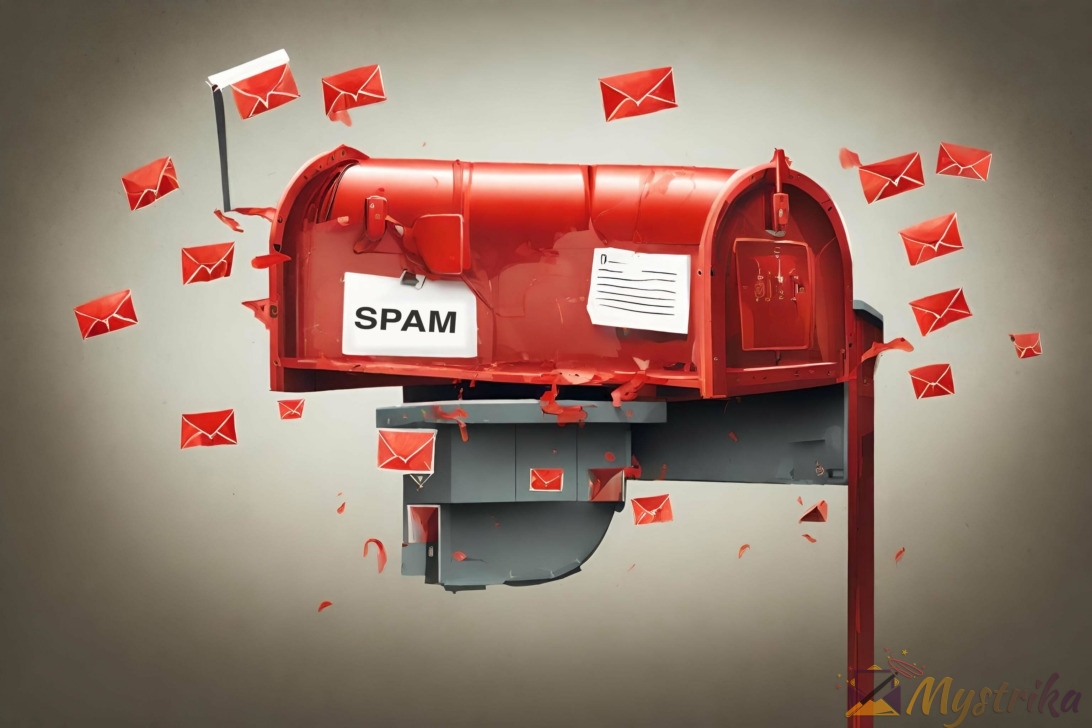Have you ever felt like your emails are being thrown into an abyss? Like they’re disappearing without a trace, never to be seen or heard from again? It’s frustrating, isn’t it? It’s as if you’re shouting at the top of your lungs and no one is listening. But what if I told you that it might not be your fault?
You see, the world of email marketing can sometimes feel like a game of roulette. Your carefully crafted messages might get flagged as spam or blocked entirely, leaving you with nothing to show for your efforts. This phenomenon is known as cold email blacklisting, and it’s something that every marketer should be aware of. But don’t worry – in this article, we’ll show you how to avoid getting blocked and increase the chances of reaching your audience. So buckle up and let’s get started!
What is Cold Email Blacklisting?
You know that feeling when you’re trying to reach out to someone important, but all your efforts seem to fall on deaf ears? That’s what happens when your emails end up in a virtual purgatory, never reaching their intended destination because of previous bad behavior. Cold email blacklisting is a common problem faced by many businesses and individuals who rely on email communication for outreach.
To avoid getting blocked, it’s crucial to understand email deliverability. Email deliverability refers to the ability of an email to successfully land in the recipient’s inbox. Factors like spam filters, bounce rates, and sender reputation all play a role in determining whether your message gets delivered or not. By maintaining good email practices and following best practices for cold emailing, you can improve your chances of having your messages reach their intended recipients.
One important factor in successful cold emailing is personalization. Generic mass emails are more likely to be flagged as spam than targeted messages that speak directly to the recipient’s needs or interests. Take the time to research your audience and personalize each message accordingly. By doing so, you’ll increase engagement rates and reduce the risk of being blacklisted due to poor engagement metrics. Now let’s dive into some common reasons for email addresses getting blacklisted.

Common Reasons for Email Addresses Getting Blacklisted
It’s like being trapped in a dark alley with no escape route when your email address gets flagged and marked as spam by the recipient’s server, leaving you stranded and unable to contact them. Email blacklist prevention is crucial if you want to avoid this situation. Here are some common reasons why email addresses get blacklisted:
- Sending unsolicited emails : Sending emails to people who never requested them or not interested in product or service is one of the most common reasons for getting blacklisted.
- High bounce rates : A high number of undeliverable or bounced emails can also lead to blacklisting consequences.
- Spam complaints : If your recipients mark your emails as spam, it could trigger an investigation by their email service provider which may result in your address becoming blacklisted.
- Using suspicious links and attachments : Including suspicious links or attachments in your emails can set off alarms for spam filters, leading to blacklisting consequences.
Don’t let these common pitfalls catch you off guard! To prevent being added to an email blacklist, make sure that you’re only sending relevant content to people who have opted-in and keep track of any bounce-backs or complaints from recipients. In the next section, we’ll discuss how you can check if your email address has been blacklisted and what steps you can take if it has been marked as spam.
How to Check if Your Email Address is Blacklisted
Discovering whether your email address has been flagged and marked as spam can be a real game-changer, so let’s dive into some quick and easy ways to check if your address is currently on the dreaded blacklist. One way to check is by using free online tools such as MX Toolbox or Blacklist Check. These tools allow you to enter your email address and scan multiple blacklists at once.
Another way to check is by monitoring your email deliverability rates. If you notice a sudden drop in open rates or an increase in bounce rates, it could mean that your emails are being blocked or filtered as spam. You can also check with your email service provider (ESP) for any notifications regarding spam complaints or blacklisting.
If you do find that your email address is on a blacklist, don’t panic! There are steps you can take for email blacklist removal and avoiding spam filters in the future. Start by identifying the reason why your address was blacklisted and addressing any issues related to it, such as improving the quality of your emails or updating your mailing list. You can then request removal from the blacklist through the appropriate channels provided by each individual blacklist organization.
Now that you know how to check if your email address has been blacklisted, let’s move on to some tips for improving email deliverability.
Tips for Improving Email Deliverability
Improve your email deliverability effortlessly with these top tips! First and foremost, you should be aware of email filtering. Email filters are designed to prevent spam or unwanted emails from reaching the recipient’s inbox. Therefore, it’s essential to avoid using words or phrases that may trigger filters. For instance, words like ‘discount’ or ‘free’ can sometimes be flagged as spam by email filters.
Another factor that affects your email deliverability is your sender reputation. The better your reputation, the more likely it is for your emails to reach their intended recipients. To improve your sender reputation, ensure that you’re sending relevant content to people who’ve opted in to receive them. Additionally, monitor any complaints and unsubscribe requests and take action accordingly.
In conclusion, improving your email deliverability requires a combination of different strategies such as understanding email filtering and maintaining a good sender reputation. By following these tips, you’ll increase the chances of getting your messages into inboxes rather than being filtered into junk mail folders or blocked altogether. Moving forward, let’s explore how segmentation and targeting can help you achieve even better results with cold emailing.
Segmentation and Targeting
To achieve better results with your emails, you’ll need to focus on segmentation and targeting. This means tailoring your messages to specific groups of people who are more likely to be interested in what you have to offer. Personalization tactics such as these can help you build stronger relationships with your subscribers and ultimately drive more conversions.
One of the main benefits of email segmentation is that it allows you to avoid sending irrelevant or off-topic messages that could annoy your subscribers. By segmenting your list based on factors like interests, preferences, and behavior, you can ensure that each person receives content that is tailored specifically for them. Not only does this improve the user experience, but it also helps increase engagement rates and reduce unsubscribe rates.
Overall, taking the time to segment and target your email campaigns can save you time and effort in the long run. Plus, by using personalization tactics like these, you can create a more engaging experience for your subscribers and ultimately drive more conversions. In the next section about timing and frequency, we’ll explore how often you should be sending emails and what times are best for maximum impact.

Timing and Frequency
When it comes to cold emailing, timing and frequency are critical factors that can make or break your campaign. You need to send your emails at the right time to maximize their impact on your audience. Additionally, you need to determine the right email frequency that strikes a balance between keeping your audience engaged and avoiding being labeled as spam. So, pay close attention to these key points if you want to achieve success with your cold email campaigns.
Send Emails at the Right Time
Make sure you’re sending your emails at the optimal time to increase the chances of them being opened and read. Email scheduling is a crucial aspect of cold email campaigns, and timing optimization can make or break your outreach efforts. The right timing depends on your target audience’s location, industry, job title, and their typical work schedule.
Research shows that emails sent during weekdays between 10 am and 2 pm have higher open rates than those sent on weekends or outside of business hours. However, these are general guidelines, and it’s essential to test different schedules to determine what works best for your specific audience. Keep in mind that sending too many emails within a short period might annoy your prospects and lead to unsubscribes or even blacklisting.
Now that you know how important timing is when it comes to cold emailing let’s move on to determining the right email frequency.
Determine the Right Email Frequency
You’ll want to find the sweet spot for how often to send your emails in order to keep your prospects engaged and interested. Email frequency optimization is key to avoiding being blacklisted by email providers. Sending too many emails can annoy people and lead them to unsubscribe from your mailing list, while sending too few may not be enough to keep them interested in what you have to say.
To help you determine the right email frequency, here are some guidelines:
- Start with a weekly or bi-weekly schedule, then adjust based on open rates and click-through rates.
- Consider the nature of your business and whether or not daily emails would be appropriate.
- Keep in mind that holidays or special promotions may require more frequent communication.
- Always ask for feedback from subscribers on their preferences for email frequency.
Now that you have an idea of how often to send your emails, it’s time to focus on optimizing the content within those messages.
Optimize Email Content
If you want to optimize your cold email content, there are three key points to keep in mind. First, make sure to write clear and concise subject lines that grab the recipient’s attention. Second, craft engaging email content that is personalized and relevant to their needs. Finally, include a clear call-to-action that prompts them to take action and respond to your message. By following these guidelines, you can increase your chances of success with cold emailing.
Write Clear and Concise Subject Lines
Don’t lose out on potential opportunities because of unclear subject lines – make sure they’re concise and engaging! Crafting effective subject lines is an essential part of writing cold emails that get opened. Here are some tips to help you write clear and concise subject lines that will grab the recipient’s attention:
- Use action-oriented language: Start your subject line with a verb that conveys urgency or importance, such as “Don’t miss out on,” “Act now,” or “Get started today.”
- Keep it short and sweet: The ideal length for a subject line is between 6-10 words, so make every word count.
- Personalization is key: Address the recipient by name and use personal details to show that you have done your research. This will increase the chances of them opening your email.
- Avoid spam trigger words: Certain words can trigger spam filters and cause your email to be blocked before it even reaches the recipient’s inbox. Stay away from terms like “free,” “guaranteed,” or anything too salesy.
Remember, crafting effective subject lines is just one aspect of writing successful cold emails. To truly engage your audience, you also need to focus on creating compelling content that speaks directly to their needs and interests.
Craft Engaging Email Content
Crafting engaging email content is crucial for connecting with your audience and driving results. Email personalization and A/B testing subject lines are two effective ways to make your message stand out in a crowded inbox. Personalization involves using the recipient’s name, past purchases, or other relevant information to create a customized email experience. A/B testing subject lines allows you to experiment with different versions of your message to see which one resonates best with your audience.
When crafting your email content, keep in mind that the goal is not just to get opens and clicks, but also to drive conversions. Make sure your message is clear and concise while also being compelling enough to inspire action. Use language that speaks directly to the reader’s needs and desires, highlighting how you can solve their problems or improve their lives. And don’t forget the importance of including a clear call-to-action at the end of your message – this will help guide them towards taking the next step in their journey with you.
Include a Clear Call-to-Action
Now that you’ve crafted an engaging email, it’s time to focus on including a clear call-to-action (CTA) for your recipient. Crafting effective CTAs can make or break the success of your cold email. Your CTA should be specific and straightforward, directing your reader to take a particular action after reading your message. It could be anything from scheduling a call with you to visiting your website.
Importance of personalization cannot be overstated when it comes to crafting CTAs. Personalized CTAs have been found to increase click-through rates by up to 202%. Use personalized language in the CTA that resonates with the recipient’s pain points and goals. This approach can help build trust with them and ultimately lead to better engagement rates. When creating your CTA, always ask yourself what you want the recipient to do after reading your email, and ensure that goal is clear in your CTA.
To avoid email bounces and complaints, it’s important to pay attention to other details such as subject lines and sender reputation.
Avoid Email Bounces and Complaints
Make sure your emails reach their intended recipients and avoid email bounces and complaints by following email marketing strategies and maintaining good email list hygiene. This means making sure that you have permission from all recipients on your list before sending any emails, as well as regularly cleaning up your list to remove inactive or non-engaged subscribers. Additionally, it’s important to keep your language and content compliant with email regulations to avoid being flagged as spam.
When it comes to avoiding email bounces specifically, there are a few things you can do. First, make sure the email addresses on your list are valid and up-to-date. Sending emails to invalid or outdated addresses will result in bounced emails. You can also use an email verification tool to check the validity of each address on your list before sending any campaigns.
Finally, it is important to avoid complaints from recipients about the content of your emails. This can lead to blacklisting by ISPs or other authorities, which can severely impact your ability to send future campaigns. Make sure that the content of your emails is relevant and valuable to each recipient on your list, and always provide an easy way for them to opt out of receiving further communications if they choose.
To ensure that all of these efforts are successful in keeping you off blacklists and out of spam folders, consider using email authentication methods such as DKIM (DomainKeys Identified Mail) or SPF (Sender Policy Framework). These protocols help verify that the sender of an email is legitimate and not a spoofed address or malicious entity. By taking these steps towards better deliverability practices, you’ll be able to maximize the effectiveness of your cold emailing campaigns without getting blocked or penalized for non-compliance.
Use Email Authentication
If you want to ensure that your emails are delivered successfully and not marked as spam, it’s important for you to use email authentication methods like DKIM or SPF. Email authentication benefits you by confirming to ISPs that your emails come from a legitimate source and are not fraudulent or malicious. This increases the chances of your emails being delivered straight into the inbox of your recipients.
However, implementing email authentication can be challenging for some businesses. It requires technical expertise and time investment to properly configure the necessary records in DNS settings. Additionally, if there are any errors or inconsistencies in the implementation process, it could lead to issues with email deliverability.
Despite these challenges, it is still highly recommended to implement email authentication as part of your email marketing strategy. By doing so, you increase the likelihood of delivering successful campaigns that reach your subscribers’ inboxes instead of getting blocked by spam filters. In the next section, we’ll discuss how monitoring email metrics can help optimize your campaign performance even further.

Monitor Email Metrics
Monitoring email metrics is crucial for optimizing your campaign performance and ensuring that your messages are reaching the right audience. Email engagement and email open rates are two of the most important metrics to keep an eye on. By monitoring these, you can determine if your emails are resonating with your audience or if they need some tweaking to improve their effectiveness.
Email engagement measures how much people interact with your emails, such as clicking on links or forwarding them to others. High engagement rates indicate that your content is valuable and interesting to recipients. On the other hand, low engagement rates mean that you may need to adjust the content or frequency of your emails.
Similarly, email open rates measure how many people actually open your emails after receiving them in their inbox. Low open rates could indicate a poor subject line or delivery time, while high open rates suggest that recipients find value in what you’re sending them. By keeping tabs on these metrics and making adjustments accordingly, you can avoid blacklisting and maintain a strong reputation as a sender.
To continue optimizing your email campaign performance, it’s essential to maintain a clean email list by regularly removing inactive subscribers and invalid addresses. This ensures that you’re only sending emails to engaged recipients who want to hear from you. With this approach, you can stay off spam filters’ radars and increase deliverability rates over time.
Maintain a Clean Email List
To maintain a clean email list, you need to regularly remove inactive subscribers and invalid email addresses. Inactive subscribers are those who haven’t engaged with your emails in a long time, and keeping them on your list can harm your deliverability rates. Invalid email addresses are ones that bounce back or are no longer valid, which also affects your overall deliverability. By regularly cleaning up your email list, you’ll have a more engaged audience and better chances of reaching their inbox.
Remove Inactive Subscribers
Removing inactive subscribers is crucial for maintaining a healthy email list and increasing the chances of reaching engaged recipients. Having a large email list may seem impressive, but if most of your subscribers are inactive, it can hurt your deliverability rate and lead to getting blacklisted. To avoid this, regularly check your email list for inactive subscribers who haven’t opened or clicked on any of your emails in the past six months or longer.
To re-engage with these subscribers, consider sending them engaging content that speaks to their interests and offers value. You could also send them a survey asking for feedback on what they would like to see more of in your emails. If all else fails, it may be time to remove them from your list altogether. By removing inactive subscribers, you’ll not only improve the health of your email list but also increase the engagement levels among active ones. This will increase the likelihood that they will open and click through on future emails.
Transitioning into removing invalid email addresses: While removing inactive subscribers is important for improving engagement rates, it’s equally important to remove invalid email addresses from your list as well.
Remove Invalid Email Addresses
Let’s ensure the cleanliness of your email list by bidding farewell to those pesky, non-existent email addresses. Email hygiene is essential in keeping your email reputation healthy and avoiding blacklisting. One way to maintain proper email hygiene is by removing invalid email addresses from your list.
Invalid email addresses are those that do not exist or have been deactivated. These emails can negatively impact your deliverability rate and increase the chances of getting marked as spam. Data verification tools can help you identify these invalid emails, allowing you to remove them from your list and improve its overall quality. By doing so, you increase the effectiveness of your campaigns and provide value to your subscribers through targeted messaging that resonates with their needs.
Provide Value to Your Subscribers
Make sure your subscribers feel like they are getting something valuable from you, so they will eagerly anticipate and open your emails. Email personalization and content relevance are crucial to providing value to your subscribers. Here are five ways to provide value:
- Send personalized offers based on their preferences
- Share exclusive content or discounts only available through email
- Provide helpful tips or resources related to their interests
- Ask for feedback or input on new products/services
- Keep them updated with industry news and trends
When you provide value to your subscribers, they are more likely to engage with your emails, which can improve deliverability rates and reduce the chances of being blacklisted.
Remember that quality over quantity is key when it comes to email marketing. Avoid bombarding your subscribers with irrelevant information or sending too many emails too frequently. This can lead to them feeling overwhelmed and ultimately unsubscribing or marking you as spam.
In order to ensure that you stay in compliance with anti-spam laws, it’s important to follow CAN-SPAM guidelines in all of your email communications. By doing so, you’ll not only avoid penalties but also build trust with your audience by showing that you respect their privacy and inbox space.
Follow CAN-SPAM Guidelines
You want to ensure that your email marketing efforts are effective and trustworthy, so it’s important to follow the CAN-SPAM guidelines to avoid any legal issues or consequences. Can spam compliance is crucial for cold email etiquette because it helps you build a good reputation with the recipients. To be compliant, you need to include a clear and concise subject line, provide an opt-out option, and include your physical address in the email.
When sending cold emails, it’s also essential to respect the recipient’s privacy by not sharing their information with third parties. You should also avoid using false or misleading information in your emails as this can lead to blacklisting and potentially damage your reputation. By following the CAN-SPAM guidelines, you demonstrate that you value your subscribers’ trust and respect their right to choose whether they receive emails from you.
Incorporating these best practices into your email marketing strategy will help prevent blacklisting and improve deliverability rates. In addition to following CAN-SPAM guidelines, building a strong email reputation requires consistent engagement with subscribers and providing valuable content that resonates with them. Next up: let’s talk about how building your email reputation can enhance your email marketing efforts even further.

Build Your Email Reputation
If you want to ensure that your cold emails are reaching their intended recipients, it’s crucial to build a positive email reputation. This involves taking steps to establish yourself as a trustworthy sender who consistently delivers relevant, high-quality content. By doing so, you can avoid getting flagged as spam and damaging your chances of future outreach success.
Build a Positive Email Reputation
When recipients see your name in their inbox, they should associate it with reliability and valuable content that they look forward to receiving. Building a positive email reputation is essential to ensure that your emails land in the recipient’s primary inbox rather than getting filtered into spam or promotions folders. Here are four best practices for email outreach to build a positive email reputation:
- Personalize your emails: Addressing the recipient by their name and mentioning specific details about them or their company shows that you have done your research and are genuinely interested in building a relationship.
- Provide value: Your emails should offer something of value, whether it’s insightful information, exclusive offers, or personalized recommendations.
- Be consistent: Sending regular emails at predictable intervals helps establish trust with the recipient and keeps them engaged.
- Respect unsubscribes: Always include an easy-to-find unsubscribe button and promptly remove anyone who opts out from your mailing list.
To avoid email blacklisting due to poor email reputation, it’s crucial to follow these best practices for email outreach consistently. In the next section, we will discuss how spamming can lead to blocked emails.
Avoid Email Spamming
Now that you’ve built a positive email reputation, it’s time to focus on avoiding email spamming. This is crucial because getting marked as spam can lead to your emails being blocked and your domain being blacklisted. To avoid this, it’s important to ensure that your email outreach is personalized and relevant to the recipient.
One of the best ways to avoid email spamming is by using personalization techniques. Personalization involves tailoring your emails to suit the recipient’s interests or needs. This can be achieved through various methods such as addressing them by name, referencing their previous purchases or interactions with your brand, or even sending targeted content based on their preferences. By doing so, you increase the chances of your emails being read and responded to positively instead of ending up in the recipient’s spam folder.
As you wrap up this article, keep in mind that building a positive email reputation and avoiding email spamming are essential steps towards successful cold emailing. In the next section, we’ll discuss some conclusion and next steps you can take to continue improving your cold emailing strategy.
Summary and Next Steps
To prevent future communication issues and establish trust with potential clients, taking the time to research and personalize your outreach messages is a crucial step towards building lasting business relationships. Avoid sending generic templates that lack personalization, as this could lead to recipients marking your messages as spam. Instead, tailor each message according to the recipient’s interests and needs.
Next steps include analyzing and optimizing your email campaigns regularly. By monitoring open rates, click-through rates, and conversion rates, you can gauge the effectiveness of your outreach efforts and identify areas for improvement. Use metrics such as engagement rate to determine which emails are resonating with recipients and adjust your messaging accordingly.
In addition to tracking metrics, consider implementing a double opt-in process for new subscribers. This involves asking users to confirm their subscription through a follow-up email after they sign up for your mailing list. It ensures that only interested individuals receive your messages while also protecting you from being flagged as spam by recipients who did not request to receive communications from you in the first place. Overall, by following these best practices for personalized messaging and effective email campaign management, you can avoid getting blacklisted while building valuable business connections.
Conclusion
In conclusion, avoiding cold email blacklisting requires diligence and adherence to best practices. It is important to regularly monitor your email deliverability and take measures to improve it, such as segmenting your audience and providing valuable content. By following CAN-SPAM guidelines and building a positive email reputation, you can avoid being marked as spam or blacklisted.
Remember that getting blocked by ISPs or email clients can harm your brand’s reputation and prevent potential customers from receiving your messages. Take the necessary steps to ensure that your emails are reaching their intended recipients and not getting lost in a sea of spam. With these tips in mind, you can continue using cold outreach effectively while avoiding the pitfalls of blacklisting.

